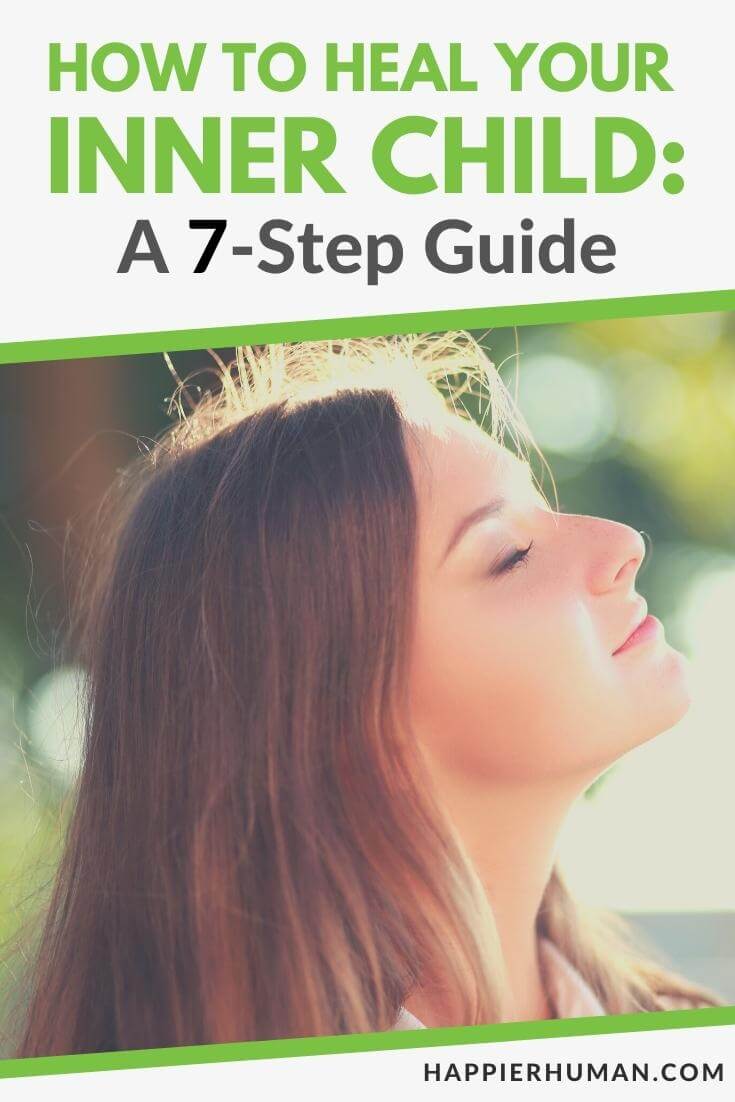There are times when I find myself shushing a little voice inside myself. This voice tells me that I should be happy in certain situations. It wants me to go out, have fun, and live a little. But then “logic and reason” assert themselves and I end up telling my little voice off.
Have you been there too? Have you told your inner voice off for being “unrealistic,” “having to grow up,” and “wasting time?” This is one of the ways in which you suppress your inner child, and you’ve been suppressing them for many years, causing painful wounds that catch up to you as an adult.
Instead of being bold and seeing wonder all around you, your life has become a dull and dreary experience that is filled with mindless responsibilities and challenges. Healing your inner child is how you begin to see life with wonder again, look forward to things, and find your mojo once more.
Luckily, you can become the healer your inner child needs. You can help heal the wounds your life experience has left you with. Here’s how.
What Is Your Inner Child?
The inner child is a concept of innocence. It’s when you access all the positive, creative, empathic, and hopeful aspects of yourself. Like a little child, who is excited over everything, enjoys life, and hopes for the best in all situations, your inner child is the side of you that hasn’t been harmed by the world.
But something happened in your childhood to damage that fragile goodness. And you ended up with scars on your inner child.
The term “inner child” often gets thrown around loosely. It tends to mean different things to everyone, but there are a few basic concepts that are the same no matter what you think you know about your inner child.
Your inner child is molded in your early childhood. The experiences, people, and places you interact with as a child will have a marked impact on your inner child’s formation.
Your inner child tends to demand attention but grows negative when they don’t get accepted for their unique world view. When your childhood was unhappy, you (your inner child) may decide you don’t trust people, and that you wish to live alone.
If you have the money, great. You can then move to a deserted island in Bora Bora. However, most of us don’t (and it isn’t a healthy way of coping), and so we need to fix our inner childhood so we can make peace with that part of ourselves and access our inner goodness and renew faith in the world.
Benefits of Acknowledging Your Inner Child
For most of us, we’ve always heard people say that you have to grow up and accept the world, do what you need to so you can live, and to stop wanting better as that’s not reality. And so, slowly and painfully, your inner child begins to hide away under layers of psychosis.

Except, your inner child can become like the doll Chucky, coming out at unexpected times to wreak havoc. When your inner child isn’t acknowledged, they begin to rebel and act out in unpredictable and unfavorable ways. Snapping at people, being grouchy, hating things that should be fun and doubting people will be the result of a withdrawn inner child.
When you acknowledge and heal your inner child, you will enjoy several benefits including:
Children trust everyone and they are happy, no matter where they go, until something happens to teach them not to do so. In life, we should be cautious, but we should also be open to new experiences and new people.
When you begin to heal your inner child, you will start to trust people again, and you will become more open about new experiences and places.
Creativity is one of a child’s best powers, and as an adult, we access our inner child to be creative and make new and exciting things. You require your inner child to make that presentation you are hosting fun, to paint your home in unique colors, or to make an exciting dinner out of leftover ingredients.
Creativity is vital for a successful and happy life. Healing your inner child will help you become more creative.
Children aren’t normally grouchy by nature. They laugh easily, smile often, and love meeting new people (even if they are a little shy at first). While you don’t have to rush out and hug strangers, being someone with a sunny nature will help you achieve more and make better connections in life.
The first reaction a child learns when receiving is to be grateful. Gratitude changes the way you see life and experience events. Instead of being upset when things don’t go your way, you look for the good, feel grateful for the lesson, and look forward to the next challenge.
As an adult, this is perhaps one of the most significant contributions your inner child gives you. Living with gratitude is how your child-self reaches out to the world, and it’s amazing how the world responds to that.
When your inner child feels safe enough to come out of hiding, you will start to experience a profound change of life outlook. You will see potential in all things, instead of looking at things and seeing your own perceived limitations. For the inner child, there are no limitations.
Signs of Inner Child Wounds
If you’re still not sure whether you have an inner child who has been scarred by life, here are some signs when that child acts out or throws a tantrum because of their fear and unhappiness.
7 Steps to Heal Your Inner Child Wounds
You’ve figured out that your inner child isn’t doing that great. Your child-self has been hurt, and the wounds were never properly cared for, which has resulted in a massive soul-infection. It’s time to rip off the band aid you stuck on all those years ago and let those cuts heal so you can live free again. Here’s how:
Step 1: Take a Breath
Babies and infants have the best type of breathing. They breathe deeply, from the belly, and there is no rush in their breaths. They trust that there will be breath when they are ready.

As we grow up, we are convinced that there is a shortage of what we need… and as a result, we start to hold onto our breath, not letting it flow.
It’s time to take a breath.
Breathe in through your nose, aiming for a gentle but deep breath. Exhale through your mouth, letting the air flow naturally and peacefully from your body. You don’t have to force anything. Just breathe.
Inhale for four seconds, wait, exhale for four seconds, wait, and begin again. Nothing is making you rush. Do this until your diaphragm relaxes and you feel each breath coming in as naturally as possible.
Step 2: Let Your Senses Lead Your Inner Child
As children, we notice the strangest things. We are amazed by the colors of a peach, and we instantly notice the scent of cut grass. Now, as a rather jaded adult, you don’t even notice these. Life just skips past, always rushing, always panicked. Time to slow down.
Close your eyes, inhale, and open your eyes slowly. Notice the first thing that you see. Close your eyes, exhale, and pay attention to the first sound you hear. Open your eyes, inhale, and feel the surface where your hands rest.
Work through all of your senses, letting your list of things you notice grow and expand as your inner child accepts the invitation to come out and play. Be gentle, and don’t rush.
Step 3: Do Something Creative
Adults are forever saying they can’t even draw a stickman, or we try to do everything that should be fun with such perfection that we hate it. Perfection is a myth.
Letting your inner child engage in creative activities where the goal isn’t to make a finished flawless result is how you break out of the perfection game. Attend art classes, go out in nature and collect pretty things like stones, leaves, and fruit, and take up a creative hobby.
Step 4: Daydream
Stop life for a second, get off the crazy train of corporate and practical living. Spend an afternoon at the park, flat on your back, gazing up at the clouds. Let your imagination come out and gaze at the clouds and see wonder.
When your adult mind tries to tell you that you are wasting time, remind it that this is your inner child’s time, and it’s theirs to use as they please. Create a safe space where there are no consequences for lazing away an afternoon and just being present and mindful.
If daydreaming is too much for your adult self, you can engage in “activities” like yoga, meditation, or Tai Chi where there is a little more structure, but you also encourage your inner child to come out of their shell.
Step 5: Engage in Self-Care
With self-care, I don’t mean a spa routine to make you look younger. Instead, this is any activity that makes you feel good.
Consider walks around the block, walking through the candy store and looking at all the treats with wide-eyed wonder, or buying a weighted blanket to simulate a hug. Listen to great music that makes you sing along or dance at 5 a.m. like you have the body of a five-year-old.
Self-care can involve getting a pet that you’d always dreamed of, and the bonus of a pet is that they are great emotional support animals, providing love and purpose.
Use affirmations to reprogram your mind to embrace life and find opportunities (keeping in mind that your inner child will help you look for those if you let them).
Step 6: Defend Your Inner Child
By now, the other adults in your life may start to question your strange behavior. It’s natural that you’ll feel ashamed of your “unsuitable” behavior.

But fight the urge to hide, and instead, stand up for your inner child. Be the adult your inner child never had as a child by defending them.
When you defend your inner child, you are protecting the honest and carefree side of yourself.
Step 7: Validate Yourself
A huge sign of having a wounded inner child is when we are constantly looking for outside validation of our lives. We begin to believe that we are nothing if not for the opinions of others.
Take a step back and stop looking for that outside validation. Instead of waiting for others to praise you for a good job, you can approve of yourself. Your (and your inner child’s) opinion is the only one that matters.
Final Thoughts on How to Heal Your Inner Child
The work of healing your inner child will take many months, if not years, to reach a state of spiritual health. You may take two steps forward today and backslide by five steps tomorrow. It’s a fluid process where you are encouraged to accept and build on what you can do, what you can achieve, and what you can process today.
Practice kindness towards your inner child. Your inner self has been through enough pain and abuse, without being pushed aside by your adult self. The result of embracing your inner child is worth the effort and kindness as you will see life through new eyes that aren’t jaded by painful experiences.
To learn more about how to live with mindfulness and awaken your inner child, read up on self-care activities in our article on mindfulness exercises to ease anxiety. Your inner child is totally worth it and deserves to stand out!


